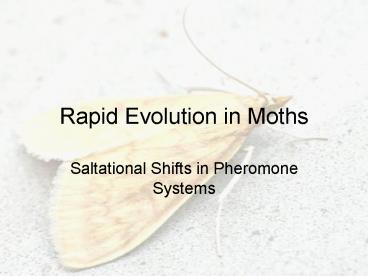Rapid Evolution in Moths - PowerPoint PPT Presentation
1 / 20
Title:
Rapid Evolution in Moths
Description:
Rapid Evolution in Moths. Saltational Shifts in Pheromone Systems. Moth Mating Behavior. Male moths use specialized, species-specific blends to fly upwind and ... – PowerPoint PPT presentation
Number of Views:31
Avg rating:3.0/5.0
Title: Rapid Evolution in Moths
1
Rapid Evolution in Moths
- Saltational Shifts in Pheromone Systems
2
Moth Mating Behavior
- Male moths use specialized, species-specific
blends to fly upwind and locate a mate. - Optomotor anemotaxis process
- Antagonist compounds in the blends of other
species
3
Pheromone Production
- Biosynthesis of pheromone components usually
begins with unsaturated fatty acid derivatives - Changes made sequentially to produce end-point
volatiles - Sometimes multiple pathways can result in the
same chemical end-point
4
(No Transcript)
5
Pheromone Systems
- Canalization of response logically prevents small
changes from accruing over time. - How, then, do pheromone systems evolve?
- Saltational shifts instant changes in female
blend or male response due to mutation.
6
Reproductive isolation add water and stir
- Mutant females can arise in a population.
- Genes for female pheromone production and male
tracking are not linked. - Allows male mutations to track new blends to
evolve independently from pheromone production in
their female counterparts.
7
Saltational Shifts
- Pheromone blends usually consist of two-three
components. - High stabilizing selection. Why?
- How likely is it that small changes could build
up?
8
Hidden Genes
- Many moths possess multiple enzymes for pheromone
production only some of these produce actual
reaction products. - Many pseudogenes and mRNA that is never
transcribed lurk in pheromone glands.
9
The Birth and Death of a Gene (not the life story
of Gene Hackman)
- Sudden activation of certain genes through a
promoter change, etc. can create new components
in a pheromone blend - Subsequent inactivation of other genes could
eliminate ancestral components from the blend
10
(No Transcript)
11
Mutations Drive Evolution
- Turning genes on and off can have profound
impacts upon the ultimate phenotype of the
organism. - Males with broadly tuned ORNs or new types of
receptors are prepared to track any new mutations
in the female population
12
ECB vs. ACB(this isnt sports, folks)
- Ostrinia species nubilalis and furnacalis
- Pheromones (Z) and (E)-11-tetradecenyl acetate
(nubilalis) (Z) and (E)-12-tetradecenyl acetate
(furnacalis) - Rare males within the ECB population
13
ECB vs. ACB
- Desaturase genes/gene products clearly play a
role in the recent speciation - Broader theme within the Lepidoptera?
- Contrast this to the situation in roaches.
- Evolutionary themes by Order?
14
Other Examples
- Trichoplusia ni mutant females and male
selective breeding to create a response - Y. rorellus unique pheromone blend compared to
others of its genus (tetradecenyl acetate) - Also, this moth has neurons sensitive to the
sympatric species pheromones
15
Questions
- Does this rapid form of evolution, i.e.
saltational shifts in pheromone systems, really
qualify as rapid evolution as our group has
defined it? Argue your case
16
Questions
- Can single mutations arise and persist long
enough to cause an insipient new species? Would
this be influenced by rapidly expanding
populations as we have previously discussed?
17
Questions
- Mating disruption is a common facet of a good IPM
program. This technique involves flooding a
field with the pheromone of a pest species (via
dispensers) such that their natural ability to
find mates is lowered or negated, reducing the
reproduction of a population. How do you think
this information about rapid evolution might
affect a good IPM decision (if at all)?
18
Questions
- Does gene multifunctionality and subsequent
diversification play a significant role in the
ancestry of gene families? Would this
diversification speed up or slow down the rate of
evolution of new species?
19
Questions
- Does linkage between olfactory receptor neuron
genes and the genes for pheromone production
(e.g. desaturases) need to occur in order to
promote rapid speciation, or would it inhibit
speciation?
20
References
- Wendell L. Roelofs and Alejandro P. Rooney.
Molecular genetics and evolution of pheromone
biosynthesis in Lepidoptera. Proc. Natl. Acad.
Sci. 100 9179-9184. - Wendell L. Roelofs et al. Evolution of moth sex
pheromones via ancestral genes. Proc. Natl.
Acad. Sci. 99 13621-13626. - Thomas C. Baker. Mechanism for saltational shifts
in pheromone communication systems. Proc. Natl.
Acad. Sci. 99 13368-13370.































